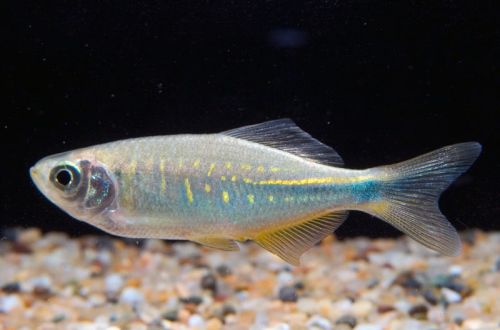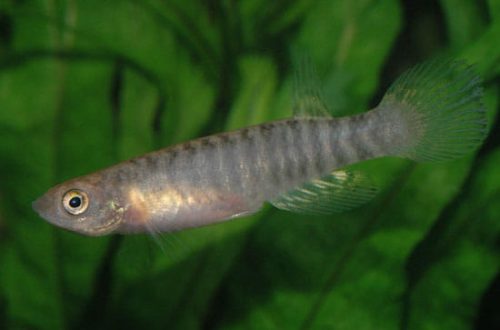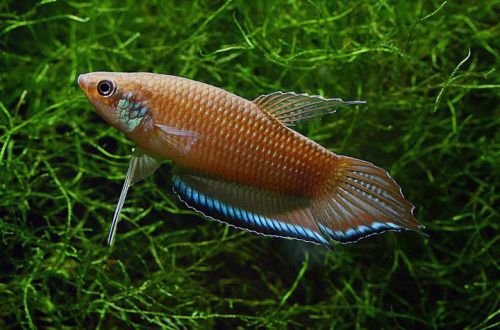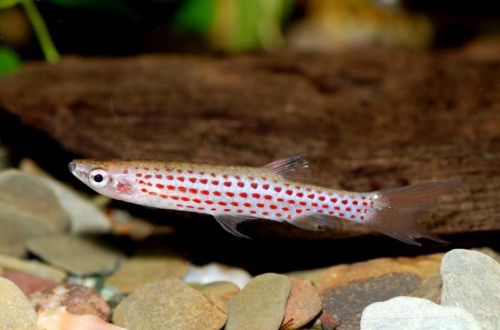
bengal danio
The Bengal Danio, scientific name Devario devario, belongs to the Cyprinidae family. An interesting schooling fish with an original non-striking body pattern, easy to keep and breed, provided that proper water quality is maintained.

Contents
Habitat
The homeland of this species is the basin of the Ganges River, which flows through the northeastern part of India, as well as through the territory of Nepal and Bangladesh. Habitat conditions in terms of hydrochemical composition and water temperature vary depending on the season. The water is muddy, with a large amount of suspension, the soil is mostly sandy-clay mixed with stones of different sizes.
Brief information:
- The volume of the aquarium – from 200 liters.
- Temperature – 15-26°C
- Value pH — 6.0–8.0
- Water hardness – soft to medium hardness (2-16 dGH)
- Substrate type – any
- Lighting – subdued
- Brackish water – no
- Water movement – moderate
- The size of the fish is up to 8 cm.
- Meals – any
- Temperament – peaceful, active
- Keeping in a flock of 8-10 individuals
Description
Adult individuals reach up to 8 cm in length, males are noticeably smaller than females, but have a brighter color. The base color is blue with yellow touches. The greatest contrast and spectacularity of the picture is achieved in low light against a background of dark soil.
Food
Bengal Danio is not at all pretentious and will gladly accept most types of feed. High-quality dry food can be used as the basis of the diet and supplemented with protein products (live and frozen bloodworms, daphnia, brine shrimp, etc.). Feed 2-3 times a day in the amount eaten in 5 minutes.
Maintenance and care, arrangement of the aquarium
A flock of fish will require a tank of 200 liters. The design uses a substrate of coarse sand, gravel, stones and boulders, as well as several shelters in the form of snags or roots, tree branches. Plants are selected with a strong root system, capable of growing in moderate flow conditions.
Although the fish come from a fairly dirty river by today’s standards, they nevertheless do not tolerate any pollution, so focus on the filtration system in the equipment. Equally important in removing contaminants is the weekly replacement of part of the water (35–50% of the volume) with fresh water. In addition to purifying the water, the filter also provides internal flow, which keeps the fish in good shape and is an important factor in successful keeping. Other recommended equipment includes a heater, aerator, and lighting fixtures. The aquarium should be equipped with a tight lid to avoid accidental jumping of the fish.
Behavior and Compatibility
A mobile schooling fish, kept in groups of 8-10 individuals, with a smaller number, they can become overly shy towards large species, or, on the contrary, aggressive towards small ones. As neighbors, it is desirable to select fish similar in size and temperament from among other cyprinids, characins, etc.
Breeding / breeding
Like most small cyprinids, the Bengal Danio belongs to spawning species, females scatter eggs in the water column, and males fertilize them at this moment, then they are left to themselves, the fish do not show any parental care and, on the contrary, can eat their own eggs, so the survival rate of juveniles in the general aquarium is at an extremely low level.
To protect the offspring, it is necessary to use a separate tank – a spawning aquarium. It is usually small in size and has a minimal set of equipment, consisting of a simple foam filter and a heater. The lighting system can be neglected, the light coming from the room will be more than enough. In the design, a substrate of large pebbles is used or the soil is covered with a fine-mesh net, or dense thickets of low small-leaved plants are planted.
Spawning is stimulated by setting the water temperature in the community tank at 25-26°C at a neutral pH. When you notice that the abdomen of the females has noticeably rounded, and the males have begun to actively show attention to their partners, then the mating season has come and it’s time to move the fish to a temporary shelter.
Spawning lasts no more than a day, after which the pairs return back. The fry appear after 24–36 hours, and begin to swim freely by the end of the second day. From this moment, you can start serving special chopped microfeed.
More about breeding Danio





